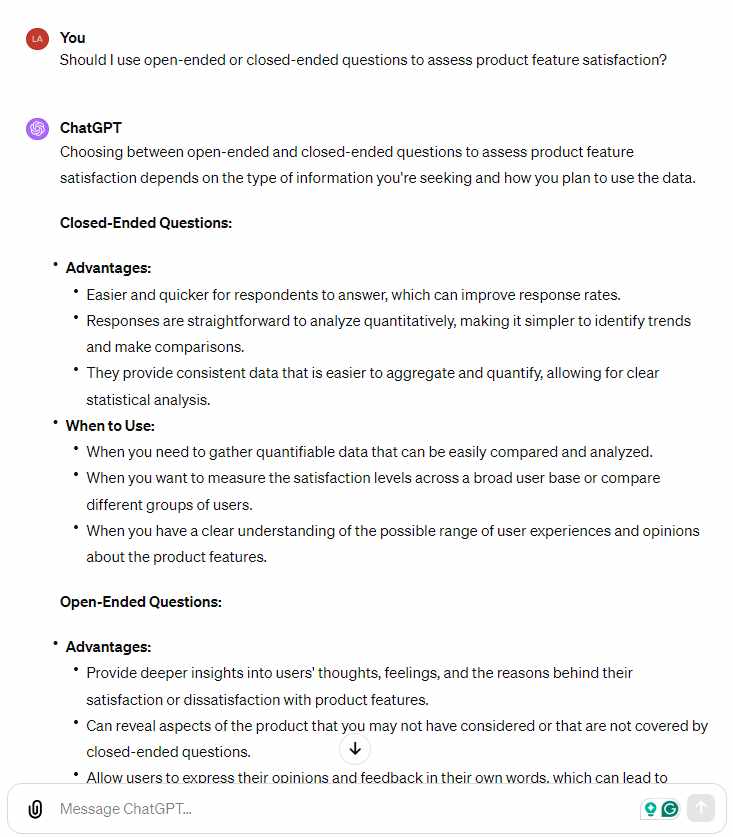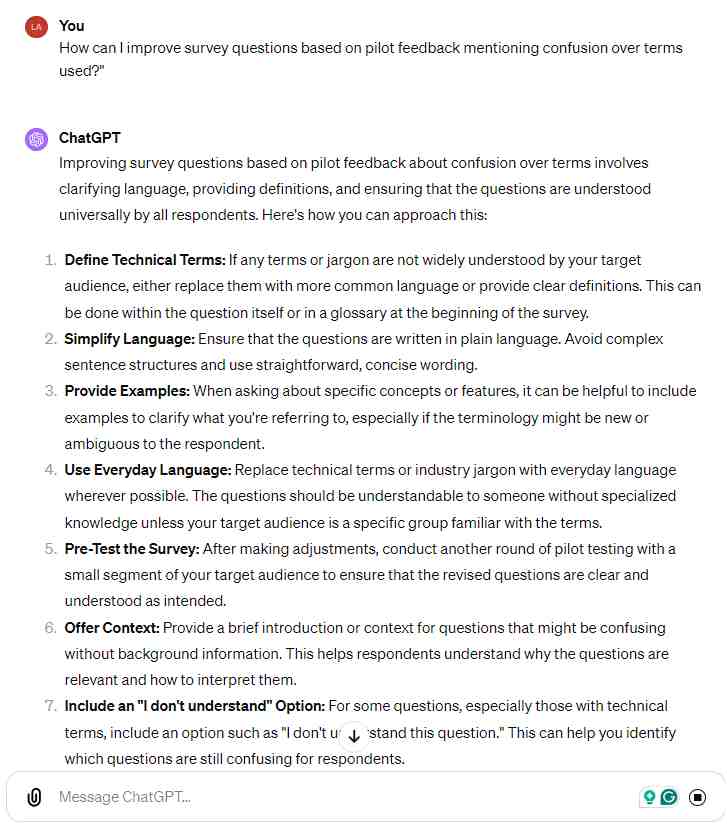In today’s data-driven world, surveys are a crucial tool for gathering insights. With the advancement of artificial intelligence (AI), creating effective survey questions has become more streamlined and efficient.
The best AI writing tools in France are revolutionizing the way we design surveys, making them more engaging and relevant to the audience. In this article, I’ll tell you how to write effective survey questions using AI writing tools in France.
How to Write Effective Survey Questions Using AI Writing Tools in France – Step-by-Step Guide
Creating effective survey questions with artificial intelligence involves understanding how AI tools process information and generate questions. These tools use algorithms trained on large datasets to recognize patterns in effective questioning and adapt these patterns to new surveys.

Step 1: Define the Survey Goals
Clearly establish what you aim to learn from the survey. Understanding your objectives will guide the creation of focused and relevant questions.
Practical Example:
I wanted to gauge customer satisfaction with our new product. I asked ChatGPT, “What are key areas to assess for customer satisfaction with a new tech product?” Using the AI’s response, I identified main themes like usability, functionality, and customer support for my survey.

Step 2: Identify Your Audience
Determine who your survey respondents will be. Knowing your audience helps tailor the questions to their knowledge level and interests.
Practical Example:
My survey targeted existing users of our tech product. I inquired with ChatGPT, “What are typical user profiles for tech gadget consumers?” The AI provided profiles that helped me customize the survey questions to fit the users’ perspectives.

Step 3: Generate Question Ideas
Use AI to produce a variety of question ideas that align with your survey goals. This step ensures a comprehensive exploration of the topics at hand.
Practical Example:
I needed diverse questions about product satisfaction. I prompted ChatGPT, “Generate question ideas for assessing satisfaction with a tech product.” The AI suggestions gave me a broad set of questions covering various aspects of user satisfaction.

Step 4: Refine Question Wording
Optimize the wording of your questions for clarity and neutrality. Precise and unbiased questions elicit more accurate responses.
Practical Example:
To refine a question on product functionality, I asked ChatGPT, “How can I rephrase ‘Do you think our product works well?’ to be more neutral and clear?”


Step 5: Format Questions for Easy Analysis
Structure your questions to facilitate easy and effective analysis. This includes deciding between open-ended or closed-ended formats based on your analysis needs.
Practical Example:
Considering analysis, I asked ChatGPT, “Should I use open-ended or closed-ended questions to assess product feature satisfaction?” The AI advised using closed-ended questions for quantitative analysis, which I implemented to simplify data analysis.

Step 6: Ensure Questions Are Non-leading and Non-biased
Review questions to ensure they are free from bias and leading language, which can influence responses and skew results.
Practical Example:
I questioned whether a question was leading and asked ChatGPT, “Is ‘How satisfied are you with our excellent product support?’ leading?” The AI confirmed it was and suggested, “How would you rate your satisfaction with our product support?” to maintain neutrality.

Step 7: Test and Revise Questions
Pilot your survey with a small, representative group using AI to analyze feedback and identify any issues with question clarity or relevance.
Practical Example:
After piloting, I collected feedback and used ChatGPT, asking, “How can I improve survey questions based on pilot feedback mentioning confusion over terms used?” The AI advised defining or simplifying technical terms, which I incorporated into the revisions.

What Are AI Surveys?
AI surveys refer to questionnaires or polls created or optimized using artificial intelligence technologies. These surveys leverage machine learning algorithms to analyze data, predict trends, and generate questions that are more likely to elicit informative responses.
Learning how to write effective survey questions using AI writing tools in France can significantly enhance AI’s ability to interpret complex data patterns, ensuring the relevance and quality of surveys.
Evolution from Traditional Surveys
AI surveys represent a significant evolution from traditional surveys. Originally, surveys relied heavily on manual formulation and distribution. This often led to biased questions and limited reach. With AI, the scope and efficiency of surveys have dramatically expanded.
Emergence of AI in Surveys
The emergence of AI in surveys marked a transformative phase. By integrating machine learning, surveys became more adaptive and insightful. AI’s ability to analyze large datasets enabled a more nuanced understanding of respondent behavior and preferences.
What Are Some Best Practices for Writing Effective AI Survey Questions?
When focusing on how to write effective survey questions using AI writing tools in France, ensuring adherence to following best practices would be helpful.
- Ensure Clarity: Make sure each question is straightforward and unambiguous to avoid confusion.
- Keep it Concise: Long-winded questions can deter engagement. Be brief yet comprehensive.
- Avoid Leading Questions: Ensure the AI doesn’t formulate questions that lead respondents to a particular answer.
- Use Simple Language: Avoid technical jargon unless your target audience is familiar with it.
- Be Specific: Vague questions yield vague answers. Aim for specificity in your queries.
- Tailor to Audience: Customize questions based on the demographic and psychographic characteristics of your audience.
- Mix Question Types: Use a variety of question types (open-ended, multiple choice, etc.) for depth.
- Test for Bias: Regularly test AI algorithms for any inherent bias in question generation.
- Continuous Learning: Update your AI tool with new data for improved question relevance over time.
- Human Oversight: Always have a human review AI-generated questions for context and appropriateness.
How Does an AI Survey Question Maker Work?
An AI survey question maker uses natural language processing (NLP) and machine learning algorithms to understand the context and purpose of a survey. Based on this understanding, it generates questions that are contextually relevant and tailored to the target audience.

Here’s an overview of how they work.
Understanding the Mechanism
AI survey question makers operate using advanced algorithms that incorporate elements of machine learning and natural language processing (NLP). These technologies enable the tool to understand and interpret human language, analyze survey objectives, and generate appropriate questions. This process involves a complex interplay of data analysis and linguistic construction.
Data Analysis and Pattern Recognition
At the core of an AI survey tool is its ability to analyze large datasets. The tool examines previous survey responses, identifies patterns in the data, and understands the type of questions that yield the most informative responses. This analysis is crucial for the AI to learn what makes a question effective in different contexts.
Natural Language Processing (NLP)
NLP is a pivotal component in AI survey tools. It allows the AI to construct questions that are not only grammatically correct but also contextually relevant. NLP enables the tool to interpret the nuances of human language, ensuring that the questions it generates are clear, concise, and easily understandable by the intended audience.
Continuous Learning and Improvement
AI survey question makers are designed to learn continuously. They adapt and improve over time, based on new data and feedback. This means that the more the tool is used, the better it becomes at generating questions that are highly relevant and engaging. This ongoing learning process is what sets AI tools apart from traditional survey methods.
Integration with Survey Goals
An essential aspect of how these tools work is their ability to align with the specific goals of a survey. Before generating questions, the AI tool requires input regarding the survey’s objectives, target audience, and key topics. This information guides the AI in creating questions that are tailored to achieve the survey’s intended outcomes.
Human-AI Collaboration
Despite the sophistication of AI survey tools, learning how to write effective survey questions using AI writing tools in France is key, as human oversight ensures that the AI-human collaboration results in questions that are not only precise but also adhere to ethical and cultural standards. This synergy between technology and human insight is essential for tailoring questions to meet the specific needs of any survey.
How to Optimize Your AI Survey Questions for Better Engagement?
To optimize AI survey questions for engagement, remember the following:
- Personalization and Relevance: Customize questions to reflect the respondent’s previous answers or profile information, making each question feel more relevant and personal to the respondent.
- Interactive and Dynamic Formats: Use engaging formats like sliders, visual selectors, or interactive scales to make the survey more visually appealing and enjoyable for respondents.
- Ensuring Question Relevance: Regularly update and refine questions to keep them relevant to current trends and topics, maintaining the survey’s appeal and effectiveness over time.
- Integrating User Feedback: Actively incorporate user feedback into the survey design, allowing for continuous improvement and adaptation of questions for better engagement.
- Aesthetically Pleasing Design Elements: Incorporate visually appealing design elements and an intuitive interface to make the survey experience more enjoyable and less cumbersome for respondents.
- Strong Call-to-Action: Include a compelling call-to-action at the end of the survey to encourage participation and emphasize the value of the respondent’s input.
What Are the Advantages of Using AI-Generated Survey Questions?
AI-generated survey questions offer several advantages:

- Efficiency and Time-Saving: AI dramatically reduces the time and effort required to create and optimize surveys, allowing for quicker deployment and more timely insights. This makes generating questionnaires far more efficient.
- Data-Driven and Insightful Questions: AI tools analyze existing data to generate questions that are more likely to yield valuable and insightful responses.
- Scalability for Large Audiences: AI-generated surveys can easily be scaled up, making them ideal for reaching large numbers of respondents efficiently.
- Personalization for Targeted Responses: AI can tailor questions based on individual respondent data, leading to more personalized and relevant surveys.
- Minimized Bias in Question Formulation: By relying on data and algorithms, AI helps reduce the potential for human bias in question creation, leading to more objective and fair surveys.
What Are the Common Mistakes to Avoid in AI Survey Questions?
Common mistakes include:
Over-Reliance on AI
While AI tools are powerful, over-relying on them without human intervention can lead to contextually inappropriate questions. Human oversight is crucial for maintaining the quality and relevance of AI-generated surveys.
Ignoring Cultural Sensitivities
AI-generated questions might overlook cultural nuances. It’s essential to ensure that the AI tool is trained on diverse datasets and that the questions are reviewed for cultural sensitivity.
Lack of Clear Objective
Without a clear objective, AI may generate irrelevant questions. It’s important to define the survey’s goal clearly before employing AI tools.
Neglecting Privacy Concerns
AI tools might inadvertently create questions that infringe on privacy. Be cautious of questions that might be too intrusive or sensitive.
Failure to Update AI Models
Learning how to write effective survey questions using AI writing tools in France is crucial, as these AI tools require regular updates with new data and feedback to avoid producing stale and ineffective questions.
FAQs
How is AI used in surveys?
Can AI answer a survey?
What questions to ask in a survey about AI?
What is the AI tool to generate questionnaires?
Conclusion
AI writing tools are a powerful asset in creating effective survey questions. They streamline the survey creation process, ensure relevance and engagement, and offer insights that might not be apparent through traditional methods.
By following best practices and avoiding common pitfalls, one can harness the full potential of AI to generate impactful survey questions.
In this article, I’ve explained how to write effective survey questions using AI writing tools in France. However, that’s not all you can use AI writing tools for. To learn more about using AI tools for various purposes, check out the how-to guides I’ve written. Alternatively, to learn more about the wider world of AI, visit the treasure trove of information that is our AI glossary.





